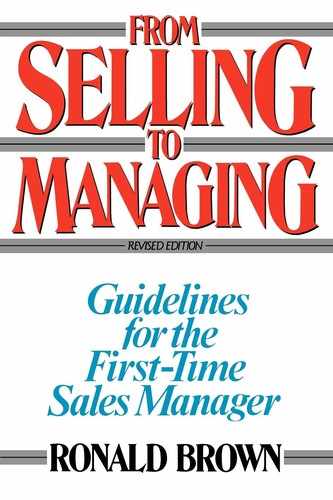Preface to the
Revised Edition
Many sales managers come to their jobs from the ranks of the sales force. They are promoted on the strength of their outstanding performances as salespeople. Few receive formal training for their new responsibilities. They are expected, rather, to make the transition from selling to managing on their own steam.
That’s why I wrote this book—to help the newly appointed field sales manager master the job. I concentrate here on the problems managers face and point out what they must do to solve them. It is my hope that the general approaches suggested will stimulate readers to think of ways of adapting them to meet individual requirements.
Since the first edition of From Selling to Managing was published, a number of important changes have occurred in the way the world does business:
1.In 1968 there were few women in sales. Today, in many organizations, up to 20 or 30 percent of the sales force are women and between 10 and 15 percent of their sales managers are women. This book has been revised to reflect these new demographics.
2.The desktop computer, the portable computer, the word processor, the fax machine—all these tools were unknown to the field sales manager of 1968. Today they are important tools of communication and control. How they can be used in many situations to make the work of the sales manager more effective is a recurrent theme of this edition.
3.In many organizations the distributor has become an important cog in the machinery linking sales, distribution, and service. Chapter 2 shows how field sales managers can use their relationship with the distributor to their company’s advantage.
The top-notch salesperson has always enjoyed a close relationship with the customer: The customer relies on the sales rep for advice, for solutions to serious problems, and for suggestions on ways of improving operations. Yet in the past, sales reps were trained in little more than knowing their company’s “line,” writing up orders and reports, and following instructions.
The ongoing technological revolution is changing the way many companies interpret the sales function. It is a lot more technically oriented today. Sometimes this means that it is easier to turn an engineer into a sales rep than to try to teach engineering knowledge to a salesperson. In any case, today’s salesperson not only sells, but educates, services, acts as a problem solver, helps the purchaser improve production or distribution, and earns the respect of the buyer through the know-how he or she is capable of displaying. This, of course, if often called Consultative Selling![]() , as developed by Mack Hanan.
, as developed by Mack Hanan.
Field sales managers and salespeople work closely together today as planners and communicators, bringing to their collaboration new ideas, solutions to problems, and improvement in procedures and policies. The field sales manager is the arm of the company, the salesperson the finger that touches the buyer far from the main office. To the buyer the sales rep is often “the company.” Together, as partners, the sales manager and sales rep strive constantly to improve performance in reaching the objectives they have accepted. It is the job of the field sales manager to create the environment that stimulates this kind of productive relationship. This book shows how it can be done.
Throughout the book, there is a constant reference to the “rep.” The reader should interpret this term as a reference to the person who represents the company before the customer and prospective customer. Our definition of the word “rep” will be: a company’s representative to the ultimate user of a product or service.
